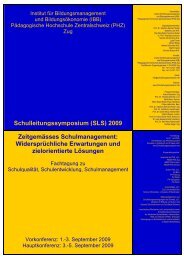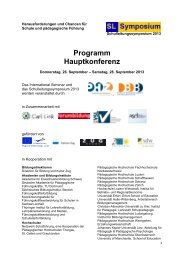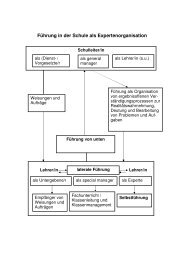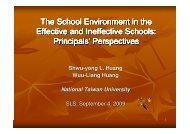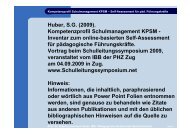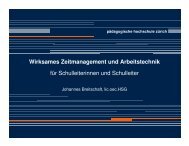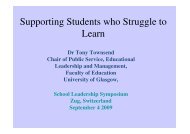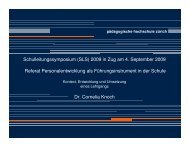Integrating Values-Education in the Daily Disciplinary Teaching
Integrating Values-Education in the Daily Disciplinary Teaching
Integrating Values-Education in the Daily Disciplinary Teaching
Create successful ePaper yourself
Turn your PDF publications into a flip-book with our unique Google optimized e-Paper software.
<strong>Integrat<strong>in</strong>g</strong> <strong>Values</strong>-<strong>Education</strong> <strong>in</strong><br />
<strong>the</strong> <strong>Daily</strong> Discipl<strong>in</strong>ary Teach<strong>in</strong>g<br />
School Leadership Symposium<br />
ZUG, Switzerland, Sept 2009<br />
Yael Edri and Nitsa Movshovitz-Hadar<br />
Technion - Israel Institute of<br />
Technology, Haifa, ISRAEL
Nathan Rotenstreich 1914-1993<br />
An Israeli philosopher<br />
Def<strong>in</strong>ition: What Is a Value?<br />
• Many philosophers addressed this issue.<br />
Various encyclopedia <strong>in</strong>clude <strong>the</strong> entry<br />
“values” with various def<strong>in</strong>itions. For this<br />
study we chose Rotenstreich’s def<strong>in</strong>ition:<br />
• “<strong>Values</strong> are pr<strong>in</strong>ciples or norms of behavior.<br />
Value is a type of content that br<strong>in</strong>gs us to<br />
prefer one action over ano<strong>the</strong>r.” (1962)<br />
2<br />
<strong>Integrat<strong>in</strong>g</strong> <strong>Values</strong> <strong>Education</strong><br />
3-5.9.09
Yeshayahu Leibowitz 1903-1994<br />
An Israeli philosopher and scientist<br />
The importance of a value<br />
• “…is def<strong>in</strong>ed as an answer to <strong>the</strong> follow<strong>in</strong>g<br />
question: What is <strong>the</strong> price that a person is<br />
will<strong>in</strong>g to pay <strong>in</strong> order to stick to that value?;<br />
that is, <strong>in</strong> order to behave accord<strong>in</strong>g to <strong>the</strong><br />
value?" (1988)<br />
3<br />
<strong>Integrat<strong>in</strong>g</strong> <strong>Values</strong> <strong>Education</strong><br />
3-5.9.09
About <strong>Values</strong>-<strong>Education</strong> <strong>in</strong> <strong>the</strong> literature<br />
Professor Shelomo Kaniel ,School of <strong>Education</strong>,<br />
University of Bar-Illan, Israel, 2008:<br />
“It is true that more emphasis on th<strong>in</strong>k<strong>in</strong>g skills<br />
with<strong>in</strong> more school subjects will lead to an<br />
<strong>in</strong>dependent learner, however not to a more<br />
moral one."<br />
Professor Hayyim Adler, School of <strong>Education</strong>,<br />
Hebrew University, Israel, 2008:<br />
“Discipl<strong>in</strong>ary subjects can nourish moral<br />
education, at least by illum<strong>in</strong>at<strong>in</strong>g <strong>the</strong>ir<br />
connections to educational values.”<br />
4<br />
<strong>Integrat<strong>in</strong>g</strong> <strong>Values</strong> <strong>Education</strong><br />
3-5.9.09
About <strong>Values</strong>-<strong>Education</strong> <strong>in</strong> <strong>the</strong> literature<br />
Professor Nimrod Allony, Kibbutz College of<br />
<strong>Education</strong>, Israel, 2008<br />
"There is a fear, that <strong>the</strong> narrow view of math<br />
education as a task without any human value,<br />
will br<strong>in</strong>g-up a generation of narrow-m<strong>in</strong>ded<br />
pupils... Such a generation will know,<br />
possibly, how to keep <strong>the</strong> tra<strong>in</strong>s runn<strong>in</strong>g on<br />
time, but may not check if that tra<strong>in</strong> is go<strong>in</strong>g to<br />
Auschwitz..."<br />
5<br />
<strong>Integrat<strong>in</strong>g</strong> <strong>Values</strong> <strong>Education</strong><br />
3-5.9.09
<strong>Values</strong>-<strong>Education</strong> and <strong>the</strong> Law<br />
The law of education, which establishes<br />
<strong>the</strong> goals of <strong>the</strong> educational system <strong>in</strong><br />
many countries, usually puts values<br />
education <strong>in</strong> <strong>the</strong> forefront of <strong>the</strong><br />
national goals for educat<strong>in</strong>g <strong>the</strong> young<br />
generation towards literate citizenship.<br />
6<br />
<strong>Integrat<strong>in</strong>g</strong> <strong>Values</strong> <strong>Education</strong><br />
3-5.9.09
<strong>Values</strong>-<strong>Education</strong> and <strong>the</strong> Law<br />
For example <strong>in</strong> my country - Israel, <strong>the</strong> law<br />
states:<br />
“To educate <strong>the</strong> <strong>in</strong>dividual to be a lov<strong>in</strong>g<br />
person, to love her/his people and country,<br />
to be a loyal citizen to <strong>the</strong> country of Israel,<br />
and to be a person who respects her/his<br />
parents, family, heritage, cultural identity<br />
and language...”<br />
7<br />
<strong>Integrat<strong>in</strong>g</strong> <strong>Values</strong> <strong>Education</strong><br />
3-5.9.09
In practice, however,<br />
• <strong>the</strong> study of subject-matter, particularly <strong>in</strong> <strong>the</strong><br />
high school level, usually takes over. Teachers<br />
become goal-oriented towards school-leav<strong>in</strong>g<br />
exams (matricukations, or o<strong>the</strong>r k<strong>in</strong>ds) and<br />
values-education subsides to an isolated corner.<br />
8<br />
<strong>Integrat<strong>in</strong>g</strong> <strong>Values</strong> <strong>Education</strong><br />
3-5.9.09
In practice, however,<br />
• The majority of <strong>the</strong> professional teachers <strong>in</strong><br />
various high-school discipl<strong>in</strong>es, devote <strong>the</strong>ir<br />
class-time to <strong>the</strong> subject-matter, and see<br />
<strong>the</strong>mselves responsible for "transmission of<br />
knowledge" ra<strong>the</strong>r than for educat<strong>in</strong>g young<br />
human-be<strong>in</strong>gs towards <strong>the</strong>ir function<strong>in</strong>g as moral<br />
citizens <strong>in</strong> <strong>the</strong> "global village".<br />
9<br />
<strong>Integrat<strong>in</strong>g</strong> <strong>Values</strong> <strong>Education</strong><br />
3-5.9.09
In practice, however,<br />
• Some teachers may even argue that this<br />
comb<strong>in</strong>ation is <strong>in</strong> contradiction to <strong>the</strong> "objective"<br />
nature of <strong>the</strong>ir discipl<strong>in</strong>e - e.g. ma<strong>the</strong>matics,<br />
sciences, technology.<br />
10<br />
<strong>Integrat<strong>in</strong>g</strong> <strong>Values</strong> <strong>Education</strong><br />
3-5.9.09
The goal of <strong>the</strong> study<br />
• The basic drive for this study stems from <strong>the</strong> a-<br />
priori assumption that, <strong>in</strong> any discipl<strong>in</strong>e, if <strong>the</strong>re<br />
is a possibility to <strong>in</strong>tertw<strong>in</strong>e values education <strong>in</strong><br />
its <strong>in</strong>struction, it must be exhausted.<br />
• The goal of <strong>the</strong> study I am present<strong>in</strong>g today<br />
was to exam<strong>in</strong>e <strong>the</strong> possibility of <strong>in</strong>tegrat<strong>in</strong>g<br />
values-education <strong>in</strong> <strong>the</strong> daily teach<strong>in</strong>g of topics<br />
<strong>in</strong> junior high-school ma<strong>the</strong>matics.<br />
• Is ma<strong>the</strong>matics a good choice as a case study<br />
for o<strong>the</strong>r discipl<strong>in</strong>es???<br />
11<br />
<strong>Integrat<strong>in</strong>g</strong> <strong>Values</strong> <strong>Education</strong><br />
3-5.9.09
After all, Ma<strong>the</strong>matics is commonly<br />
perceived as<br />
• “Value-free” discipl<strong>in</strong>e<br />
• Objective<br />
• Rationale<br />
• Everyth<strong>in</strong>g <strong>in</strong> it is ei<strong>the</strong>r true or false. No<br />
dilemma<br />
• Relative to o<strong>the</strong>r school discipl<strong>in</strong>es, it is<br />
far<strong>the</strong>st from values education<br />
So, ma<strong>the</strong>matics seems to be “<strong>the</strong> worst<br />
case”<br />
12<br />
<strong>Integrat<strong>in</strong>g</strong> <strong>Values</strong> <strong>Education</strong><br />
3-5.9.09
So, Why Ma<strong>the</strong>matics?<br />
• Because this is a true challenge<br />
Math<br />
Instruction<br />
?<br />
<strong>Values</strong>education<br />
• Because if it is possible <strong>in</strong> math, it is likely to be<br />
possible <strong>in</strong> o<strong>the</strong>r “softer” discipl<strong>in</strong>es;<br />
• and - - because both researchers’ background<br />
is <strong>in</strong> math.<br />
13<br />
<strong>Integrat<strong>in</strong>g</strong> <strong>Values</strong> <strong>Education</strong><br />
3-5.9.09
The Study<br />
In this study we attempted at answer<strong>in</strong>g <strong>the</strong><br />
follow<strong>in</strong>g questions:<br />
1. What potential opportunities for values<br />
education can be p<strong>in</strong>po<strong>in</strong>ted <strong>in</strong> <strong>the</strong> syllabus of<br />
Junior high school ma<strong>the</strong>matics? (The outcome<br />
was named: “The annotated curriculum”)<br />
2. To what extent can experienced math teachers<br />
use <strong>the</strong> annotated curriculum as an <strong>in</strong>spiration<br />
and tool for <strong>in</strong>tegrat<strong>in</strong>g values <strong>in</strong>to <strong>the</strong>ir<br />
teach<strong>in</strong>g? and <strong>in</strong> what ways do <strong>the</strong>y do it?<br />
3. What is <strong>the</strong> impact of <strong>the</strong> above on teachers’<br />
self esteem and professional perception?<br />
14<br />
<strong>Integrat<strong>in</strong>g</strong> <strong>Values</strong> <strong>Education</strong><br />
3-5.9.09
The methodology (quest. 1)<br />
Typical concepts and notions were connected to<br />
<strong>the</strong>ir social mean<strong>in</strong>g (e.g. equation and social<br />
equity).<br />
Typical word-problems <strong>in</strong> 8<br />
th grade text books<br />
(e.g. “ two tra<strong>in</strong>s go from A to B…”, “The price<br />
for 3 kg of … is…, what is <strong>the</strong> sale price if <strong>the</strong><br />
reduction is 15%?) were adapted to valueseducation<br />
context. An example follows -<br />
15<br />
<strong>Integrat<strong>in</strong>g</strong> <strong>Values</strong> <strong>Education</strong><br />
3-5.9.09
Example<br />
A typical problem “from <strong>the</strong> book”<br />
Three <strong>in</strong>gredients are needed to prepare<br />
a salad dress<strong>in</strong>g: Orange v<strong>in</strong>egar, Olive<br />
oil and Soya sauce <strong>in</strong> ratio of 1:2:3<br />
a. What is <strong>the</strong> ratio between <strong>the</strong> v<strong>in</strong>egar and <strong>the</strong><br />
soya (answer – 1:3)<br />
b. What is <strong>the</strong> ratio between <strong>the</strong> oil and <strong>the</strong> soya?<br />
(answer – 2:3)<br />
c. What quantity of each <strong>in</strong>gredient is required to<br />
prepare 240 grams of dress<strong>in</strong>g? (answer – 40<br />
grams,80 grams,120 grams)<br />
16<br />
<strong>Integrat<strong>in</strong>g</strong> <strong>Values</strong> <strong>Education</strong><br />
3-5.9.09
Example<br />
Adaptation to <strong>Values</strong>-<strong>Education</strong> context<br />
Three friends - David, Sara and Jacob, decided to<br />
jo<strong>in</strong>tly save money <strong>in</strong> order to do good deeds.<br />
They each put-<strong>in</strong> ten percent of <strong>the</strong>ir weekly<br />
allowances. It turned out that <strong>the</strong>y donated at a<br />
ratio of 1:2:3.<br />
a. What is <strong>the</strong> ratio between <strong>the</strong> David’s and<br />
Jacob’s donations? (answer – 1:3)<br />
b. What is <strong>the</strong> ratio between Sara’s and Jacob’s<br />
donations? (answer – 2:3)<br />
c. How much will each donate till <strong>the</strong>y save 240<br />
NIS? (answer – 40 NIS,80 NIS,120 NIS)<br />
17<br />
<strong>Integrat<strong>in</strong>g</strong> <strong>Values</strong> <strong>Education</strong><br />
3-5.9.09
Extend<strong>in</strong>g <strong>the</strong> example<br />
At one po<strong>in</strong>t <strong>the</strong>y decided to donate 50 NIS to<br />
children suffer<strong>in</strong>g from autism.<br />
To <strong>the</strong>ir surprise, <strong>the</strong> Association for Autistic<br />
Children sent <strong>the</strong>m a gift card to buy books <strong>in</strong><br />
<strong>the</strong> amount of 240 NIS.<br />
18<br />
<strong>Integrat<strong>in</strong>g</strong> <strong>Values</strong> <strong>Education</strong><br />
3-5.9.09
Extend<strong>in</strong>g <strong>the</strong> example<br />
• You need to suggest two different ways to fairly<br />
divide up <strong>the</strong> w<strong>in</strong>n<strong>in</strong>gs (240 NIS) between <strong>the</strong> three<br />
partners.<br />
Which way seems to be <strong>the</strong> best option, and why?<br />
• If <strong>the</strong> partners had won a prize of 240,000 NIS,<br />
would you change your m<strong>in</strong>d about <strong>the</strong> division of<br />
<strong>the</strong> w<strong>in</strong>n<strong>in</strong>gs?<br />
• Share your op<strong>in</strong>ion with ano<strong>the</strong>r pupil and <strong>the</strong>n<br />
discuss <strong>the</strong> different approaches you took.<br />
19<br />
<strong>Integrat<strong>in</strong>g</strong> <strong>Values</strong> <strong>Education</strong><br />
3-5.9.09
Example -<br />
Student’s answers<br />
240 NIS<br />
• For divid<strong>in</strong>g <strong>the</strong> w<strong>in</strong>n<strong>in</strong>gs equally<br />
• They did not donate equally; however, this<br />
arrangement seems fair because each person<br />
donated accord<strong>in</strong>g to what he/she was able to.<br />
• The arrangement between <strong>the</strong> students is not a<br />
f<strong>in</strong>ancial arrangement, but ra<strong>the</strong>r a social one<br />
and, <strong>the</strong>refore, it seems to me fair to divide <strong>the</strong><br />
w<strong>in</strong>n<strong>in</strong>gs evenly.<br />
20<br />
<strong>Integrat<strong>in</strong>g</strong> <strong>Values</strong> <strong>Education</strong><br />
3-5.9.09
Example - Student’s answers<br />
• The arrangement seems fair because <strong>the</strong>y<br />
reached it by a jo<strong>in</strong>t agreement.<br />
• In a good society, <strong>the</strong>re are always cases where<br />
one friend contributes more than ano<strong>the</strong>r friend.<br />
None<strong>the</strong>less, next time it could be different. In<br />
my op<strong>in</strong>ion, this is how life is: you may be <strong>the</strong><br />
one giv<strong>in</strong>g to your friend this time, but <strong>in</strong> <strong>the</strong><br />
future when you need him/her, he/she will be<br />
<strong>the</strong>re for you.<br />
21<br />
<strong>Integrat<strong>in</strong>g</strong> <strong>Values</strong> <strong>Education</strong><br />
3-5.9.09
Example - Student’s answers<br />
• For divid<strong>in</strong>g <strong>the</strong> w<strong>in</strong>n<strong>in</strong>gs <strong>in</strong> proportion to<br />
donation<br />
• The three friends did not contribute to <strong>the</strong> pot<br />
equally <strong>the</strong>refore <strong>the</strong> division of <strong>the</strong> prize should<br />
not be equal.<br />
• The friends will divide <strong>the</strong> prize fairly. Each one<br />
will receive <strong>the</strong> percent of <strong>the</strong> prize accord<strong>in</strong>g to<br />
<strong>the</strong> donation <strong>the</strong>y made to <strong>the</strong> pot: 40 NIS, 80<br />
NIS and 120 NIS.<br />
22<br />
<strong>Integrat<strong>in</strong>g</strong> <strong>Values</strong> <strong>Education</strong><br />
3-5.9.09
Example - Student’s answers<br />
240,000 NIS<br />
• For divid<strong>in</strong>g <strong>the</strong> w<strong>in</strong>n<strong>in</strong>gs equally<br />
• Because <strong>the</strong>re is a large amount of money<br />
<strong>in</strong>volved, I would change my m<strong>in</strong>d <strong>in</strong> this case<br />
and divide <strong>the</strong> money up evenly.<br />
• For divid<strong>in</strong>g <strong>the</strong> w<strong>in</strong>n<strong>in</strong>gs <strong>in</strong> proportion to<br />
donation<br />
• I would not change my m<strong>in</strong>d. They should get<br />
120,000 NIS, 80,000 NIS and 40,000 NIS<br />
accord<strong>in</strong>g to <strong>the</strong>ir orig<strong>in</strong>al donation.<br />
23<br />
<strong>Integrat<strong>in</strong>g</strong> <strong>Values</strong> <strong>Education</strong><br />
3-5.9.09
Example - Student’s answers<br />
• For a revised division<br />
• In <strong>the</strong> case of w<strong>in</strong>n<strong>in</strong>g a very large amount of<br />
money, I would divide <strong>the</strong> money up accord<strong>in</strong>g<br />
to f<strong>in</strong>ancial status of each family: A family that<br />
needs more will receive a higher percentage.<br />
The arguments expla<strong>in</strong>ed above were written by<br />
8 th graders at Hof Hacarmel School, Israel,<br />
2008-2009.<br />
24<br />
<strong>Integrat<strong>in</strong>g</strong> <strong>Values</strong> <strong>Education</strong><br />
3-5.9.09
Empirical study (quest. 2)<br />
12 Math teachers from 7 high-schools participated, <strong>in</strong><br />
reward to 2 weekly hours.<br />
Each of <strong>the</strong>m prepared and taught 6 lessons dur<strong>in</strong>g<br />
<strong>the</strong> school year, <strong>in</strong> each of which <strong>Values</strong>-<strong>Education</strong><br />
was entw<strong>in</strong>ed.<br />
Dur<strong>in</strong>g <strong>the</strong> year <strong>the</strong> researcher met <strong>the</strong>m for 5<br />
workshops <strong>in</strong> which <strong>the</strong>y learned to <strong>in</strong>tegrate<br />
<strong>Values</strong>-<strong>Education</strong> with Math-<strong>Education</strong> us<strong>in</strong>g <strong>the</strong><br />
annotated curriculum.<br />
Dur<strong>in</strong>g <strong>the</strong> experiment <strong>the</strong>y wrote personal journals<br />
and shared <strong>the</strong>re experiences with<strong>in</strong> a forum – a<br />
25<br />
<strong>Integrat<strong>in</strong>g</strong> <strong>Values</strong> <strong>Education</strong><br />
3-5.9.09<br />
designated site on <strong>the</strong> Web.
Results of <strong>the</strong> Empirical study<br />
12 math-teachers gave 71 “special lessons” <strong>in</strong> <strong>the</strong> 8 th<br />
class, <strong>in</strong> which <strong>the</strong>y <strong>in</strong>tegrated values education with<br />
math education.<br />
In 53% of <strong>the</strong> lessons <strong>the</strong>y planned and implemented<br />
educat<strong>in</strong>g to personal values that are <strong>in</strong>herent to<br />
math education: logical th<strong>in</strong>k<strong>in</strong>g, accuracy, criticism<br />
In 47% of <strong>the</strong> lessons <strong>the</strong>y planned and implemented<br />
educat<strong>in</strong>g to social values that are less <strong>in</strong>herent to<br />
math education: tolerance, help<strong>in</strong>g to each o<strong>the</strong>r,<br />
respect<strong>in</strong>g o<strong>the</strong>rs, forbearance of violence.<br />
26<br />
<strong>Integrat<strong>in</strong>g</strong> <strong>Values</strong> <strong>Education</strong><br />
3-5.9.09
The impact on teachers (quest. 3)<br />
Teachers changed <strong>the</strong>ir perceptions about <strong>the</strong>ir<br />
profession as math teachers:<br />
1. They became aware to <strong>the</strong>ir responsibility to<br />
educate dur<strong>in</strong>g <strong>the</strong>ir <strong>in</strong>struction.<br />
2. They reported on change <strong>in</strong> plann<strong>in</strong>g <strong>the</strong>ir<br />
lessons and <strong>in</strong> <strong>the</strong>ir possibility to cope with<br />
difficulties <strong>in</strong> <strong>the</strong> class.<br />
27<br />
<strong>Integrat<strong>in</strong>g</strong> <strong>Values</strong> <strong>Education</strong><br />
3-5.9.09
Thank you<br />
29<br />
<strong>Integrat<strong>in</strong>g</strong> <strong>Values</strong> <strong>Education</strong><br />
3-5.9.09



